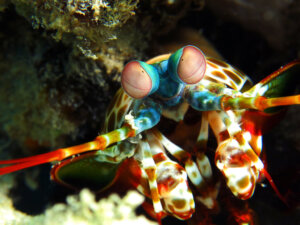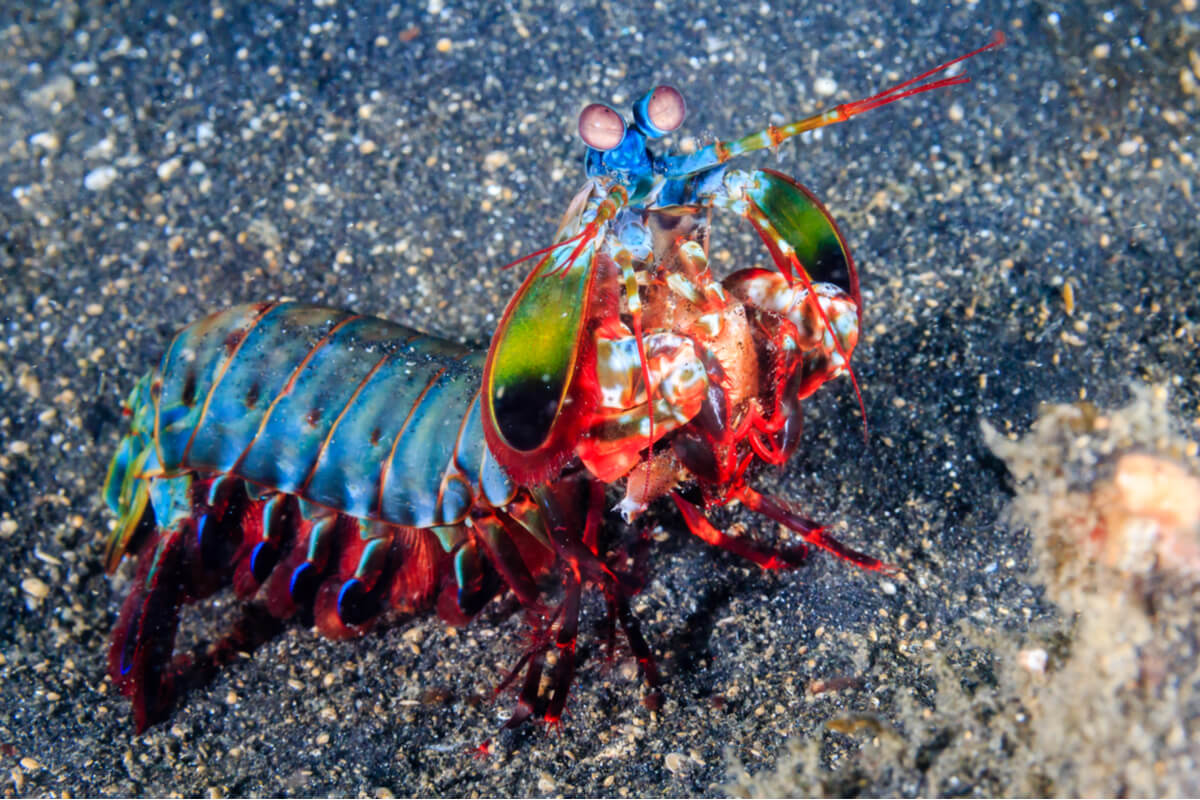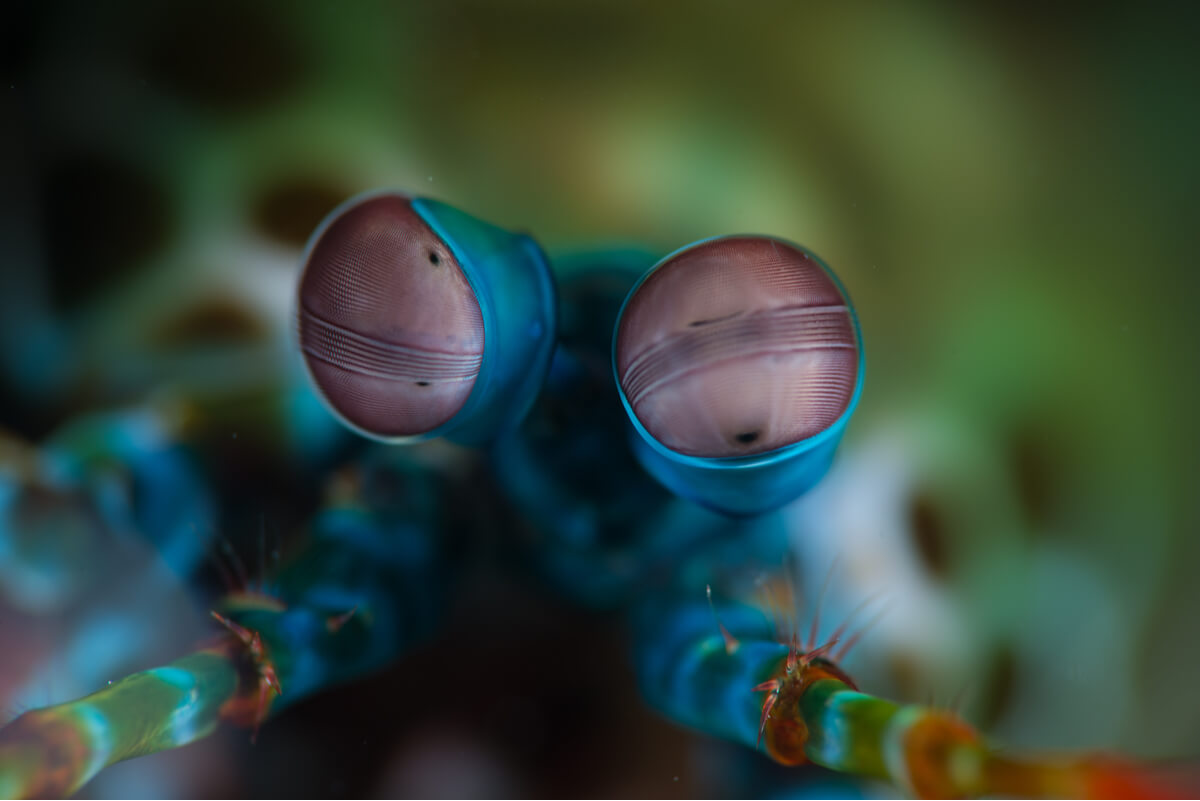The Unique Vision of the Mantis Shrimp

Vision plays a fundamental role in animals. In most cases, visual ability can make the difference in survival. However, the sense of sight hasn’t developed in the same way in all species. For example, the vision of the mantis shrimp has been a mystery that, little by little, scientists have tried to solve.
In this article, we’ll tell you the findings of a study about the curious vision of the mantis shrimp, also known as the rainbow mantis shrimp, and many other names! Discover what’s so special about the sight of this colorful predator.
The mantis shrimp

Known by the scientific name of Odontodactylus Scyllarus, mantis shrimp are invertebrate crustaceans that belong to the stomatopods. There are about 400 different species of this shrimp in the world. And, in addition to standing out for their color and fluorescence, they’re fast and fierce, with claws with a morphology similar to that of praying mantises.
These predators live in lairs, but sometimes come out of them to hunt. In fact, they’re capable of defeating prey twice their size. Aside from their claws, they have arms that can deliver brutal blows thanks to a structure in which they store and release energy quickly.
The mantis shrimp’s vision
Perhaps the most striking feature of these marine heavyweights, however, is their sense of sight. Mantis shrimp have a pair of eyes that can move independently of each other and are stereoscopic.
Most living things have two to four photoreceptors, that is, specialized neurons that help distinguish colors, are sensitive to light, and are located in the outer retina of vertebrates. However, the unusual vision of the mantis shrimp is the only one that has twelve photoreceptors or color channels.
They distinguish colors worse, but are faster
This marine species has a different way of encoding colors, and this process was discovered by an international team of researchers who were trying to solve the mysteries surrounding the visual capacity of this animal.
In the study, which was published in the journal Science, color discrimination tests were carried out by pairing stomatopods. In this way, it was concluded that these crustaceans have a unique sense of sight to distinguish color extremely fast, but without discriminating between the wavelengths of a spectrum.
To understand it better, it should be noted that the vision of humans and animals is based on the primary colors red, green, and blue (RGB system). That is, they identify colors according to the excitation they receive through these three inputs. However, the mantis shrimp, thanks to its twelve photoreceptors, follows a pattern of excitation across the spectrum.
The sense of sight of the mantis shrimp is considered the most complex in the animal kingdom. This crustacean uses a vision system that hasn’t been identified before in other living beings – based on temporal signaling combined with exploratory eye movements. They distinguish colors worse, but are faster.
Energy saving
The researchers of this study suggested that this simpler form of vision may represent an advantage for the mantis shrimp. Since this crustacean has a simpler neural network and uses less energy to identify colors, its movements are faster.
This makes the mantis shrimp an agile animal. Moreover, this energy saving could be one of the reasons why this marine animal is so efficient in responding to mating situations or territorial fights that it ends up winning even when faced with larger creatures.
But the mystery still isn’t solved. Scientists are not entirely sure how the curious vision of the mantis shrimp works. The only thing that is taken for granted is that if they had a visual system like other species, they would have to maintain a more complex neural architecture and expend much more energy.
Final considerations

In conclusion, the twelve photoreceptors of the mantis shrimp represent a unique feature within the animal kingdom. And this simple form of vision contributes to the speed with which these marine knockouts identify colors, even if they aren’t always accurate in this distinction.
Likewise, and as we’ve already mentioned, there’s still much to be discovered about this animal’s peculiar sense of sight. However, it’s clear that it isn’t only a fierce and colorful animal, but also a crustacean that doesn’t discriminate between the wavelengths of a spectrum, as other living beings normally do.
Vision plays a fundamental role in animals. In most cases, visual ability can make the difference in survival. However, the sense of sight hasn’t developed in the same way in all species. For example, the vision of the mantis shrimp has been a mystery that, little by little, scientists have tried to solve.
In this article, we’ll tell you the findings of a study about the curious vision of the mantis shrimp, also known as the rainbow mantis shrimp, and many other names! Discover what’s so special about the sight of this colorful predator.
The mantis shrimp

Known by the scientific name of Odontodactylus Scyllarus, mantis shrimp are invertebrate crustaceans that belong to the stomatopods. There are about 400 different species of this shrimp in the world. And, in addition to standing out for their color and fluorescence, they’re fast and fierce, with claws with a morphology similar to that of praying mantises.
These predators live in lairs, but sometimes come out of them to hunt. In fact, they’re capable of defeating prey twice their size. Aside from their claws, they have arms that can deliver brutal blows thanks to a structure in which they store and release energy quickly.
The mantis shrimp’s vision
Perhaps the most striking feature of these marine heavyweights, however, is their sense of sight. Mantis shrimp have a pair of eyes that can move independently of each other and are stereoscopic.
Most living things have two to four photoreceptors, that is, specialized neurons that help distinguish colors, are sensitive to light, and are located in the outer retina of vertebrates. However, the unusual vision of the mantis shrimp is the only one that has twelve photoreceptors or color channels.
They distinguish colors worse, but are faster
This marine species has a different way of encoding colors, and this process was discovered by an international team of researchers who were trying to solve the mysteries surrounding the visual capacity of this animal.
In the study, which was published in the journal Science, color discrimination tests were carried out by pairing stomatopods. In this way, it was concluded that these crustaceans have a unique sense of sight to distinguish color extremely fast, but without discriminating between the wavelengths of a spectrum.
To understand it better, it should be noted that the vision of humans and animals is based on the primary colors red, green, and blue (RGB system). That is, they identify colors according to the excitation they receive through these three inputs. However, the mantis shrimp, thanks to its twelve photoreceptors, follows a pattern of excitation across the spectrum.
The sense of sight of the mantis shrimp is considered the most complex in the animal kingdom. This crustacean uses a vision system that hasn’t been identified before in other living beings – based on temporal signaling combined with exploratory eye movements. They distinguish colors worse, but are faster.
Energy saving
The researchers of this study suggested that this simpler form of vision may represent an advantage for the mantis shrimp. Since this crustacean has a simpler neural network and uses less energy to identify colors, its movements are faster.
This makes the mantis shrimp an agile animal. Moreover, this energy saving could be one of the reasons why this marine animal is so efficient in responding to mating situations or territorial fights that it ends up winning even when faced with larger creatures.
But the mystery still isn’t solved. Scientists are not entirely sure how the curious vision of the mantis shrimp works. The only thing that is taken for granted is that if they had a visual system like other species, they would have to maintain a more complex neural architecture and expend much more energy.
Final considerations

In conclusion, the twelve photoreceptors of the mantis shrimp represent a unique feature within the animal kingdom. And this simple form of vision contributes to the speed with which these marine knockouts identify colors, even if they aren’t always accurate in this distinction.
Likewise, and as we’ve already mentioned, there’s still much to be discovered about this animal’s peculiar sense of sight. However, it’s clear that it isn’t only a fierce and colorful animal, but also a crustacean that doesn’t discriminate between the wavelengths of a spectrum, as other living beings normally do.
All cited sources were thoroughly reviewed by our team to ensure their quality, reliability, currency, and validity. The bibliography of this article was considered reliable and of academic or scientific accuracy.
- Una forma diferente de visión del color en el camarón mantis. Science. Recogido el 30 de marzo de 2022 de: https://www.science.org/doi/10.1126/science.1245824?adobe_mc=MCMID%3D62865672335065496422378199988234470758%7CMCORGID%3D242B6472541199F70A4C98A6%2540AdobeOrg%7CTS%3D1648659211&_ga=2.10901040.523696915.1648659019-1840617778.1648659019
- Los fotorreceptores, esas fascinantes células. Repositorio Institucional de la Universidad de Alicante. Recogido el 30 de marzo de 2022 de: https://rua.ua.es/dspace/bitstream/10045/16760/1/noviembre2009_nicolascuenca.pdf
This text is provided for informational purposes only and does not replace consultation with a professional. If in doubt, consult your specialist.








